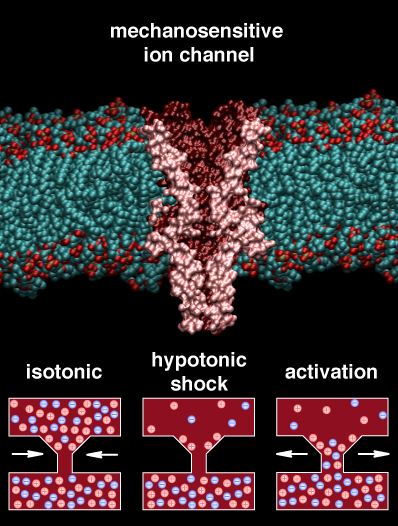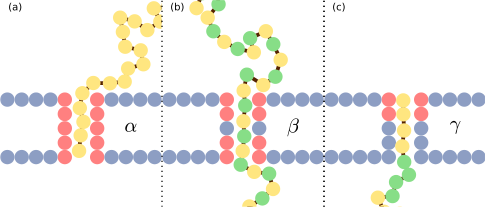Dynamics of water, ions and polymers in nanopores

Tension due to double layer stress
Ion channel gating, which is of crucial importance to all living organisms, relies on the appearance of open and closed conformational states of the channel protein. In large aqueous pores, an essential component of the forces acting on the channel wall that lead to gating is the stress caused by the water and ions inside the channel.
We show how a two-state system emerges from these diffusio-osmotic forces in a simplified model of a bacterial mechanosensitive ion channel. Mechanosensitive ion channels open large pores in the cell membrane to relieve the increase in osmotic pressure inside a microbe resulting from exposure to a rapidly decreasing salt concentration (hypotonic shock). Despite their very fundamental physiological role, a physical understanding of the two-state gating kinetics of these ion channels has remained elusive so far. Using a model based on experimental crystal structures, we reveal the underlying physics of the channel's complex biological function, showing that its two-state gating kinetics are fully reproduced within a structure consisting of only a charged vestibule and a hydrophobic constriction. Because these elements are shared features of many different ion channels, our proposed mechanism to produce a two-state gating system is likely to be important for a broad range of ion channels.
Group members involved: D. J. Bonthuis and R. Golestanian
Noise in nanopore experiments
Experimental measurements of ionic currents and water flows through nanometre-sized channels are inherently troubled by high levels of noise. In many different nanopore systems, the noise spectrum exhibits a power-law behaviour at low frequencies, the origin of which has been a mystery for many decades. Apart from being a nuisance, however, the noise spectrum can be used to study important characteristics of the nanopore if the particularities of the spectrum can be linked to the physical properties of the nanopore, such as the geometry, the flexibility of the pore wall, or the surface charge density.
We study the origin of the power-law noise spectrum in model nanopores using Brownian dynamics simulations, with the aim to extract information from the noise about the structural properties of the nanopore, as well as the dynamics of the ions inside.
Group members involved: D. J. Bonthuis, M. Zorkot and R. Golestanian
Polymer transport through oscillating pores

The translocation of a polymer through a pore is important in the context of many biological processes such as the transport of RNA through a nuclear membrane pore and the injection of viruses. Most theoretical studies consider the pore as static with the polymer always experiencing a constant confinement during its translocation from the
We use a coarse-grained model to study translocation of a polymer through a narrow channel with a width that oscillates with a given frequency. We find that the translocation can be significantly enhanced when compared to a static pore that has a width equal to the mean width of the oscillating pore. The gain in translocation exhibits a strong dependence on the stickiness of the pore. Although the translocation time itself is sensitive to the initial condition, the high frequency behaviour of the gain is insensitive to it. This robust high frequency behaviour of the system has remarkable implications. It suggest that even stochastic flickering of the pore will result in a steady average translocation with a gain that can be tuned via the driving force across the channel and the stickiness of the pore, as long as the time period of oscillation is orders of magnitude greater than the translocation time. Moreover, since the translocation rate for such random flickering pores is extremely sensitive to the stickiness of the pore, this brings about the possibility of a high degree of robust selectivity in the translocation process.
Group members involved: J.A. Cohen (alumnus), A. Chaudhuri (alumnus) and R. Golestanian
Stochastic Sensing

Accurate, affordable and rapid DNA sequencing would have an incredible impact on our understanding of genetics and on diagnoisis and treatment in the field of medicine. Experiments have demonstrated that single stranded DNA and RNA molecules can be electrophoretically driven through biological and synthetic nanopores. During this translocation process, the ion current flowing through the channel is blocked which indicates the presence of the polymer inside the pore. It has been postulated that the modulation of the ionic current as it passes through the nanopore could serve as a potential method of DNA sequencing provided the each nucleotide of the polymer produced a characteristic modulation. A major challenge for the significant majority of the approaches that use the readout from translocation speed as a signature of the sequence is irreproducibility of the individual events due to the inherent stochastic nature of the process. To help overcome this source of error, it has been suggested that the process be slowed down by orders of magnitude such that time-averaging would eliminate statistical noise.
Using Langevin Dynamics simulations of a coarse grained polymer model we have demonstrated that it is possible to take advantage of the very stochasticity of the translocation process towards fast and accurate sequencing of polynucleotides, by engineering the shape and quantitative features of the translocation time probability distribution. We have considered pores with patterned surface energetics and observe that the translocation process of a homopolymer is extremely sensitive to the detailed structure of such patterns with faster than exponential dependence of the translocation time on the stickiness of the pore. This suggests that seemingly insignificant changes in the stickiness pattern and strength of the wall of the pore could modify the translocation time by several orders of magnitude. This opens up the possibility that heteropolymers of any given sequence will have distinct statistical features that could be used for stochastic sequence detection. Indeed using two types of different pores with distinct translocation time statistics, we demonstrate that the sequence of an unknown polynucleotide can be detected with arbitrary accuracy from the stochastic translocation time readout, when a sufficient number of the engineered pores are assembled in series.
Our strategy is based on designing distinguishable translocation time statistics for any given sequence by engineering the polymer-pore interactions and combining readouts from multiple pores for rapid convergence. The desired patterns in surface interaction could be achieved by using biological nanopores with appropriate modification or those with known hydrophobic-hydrophilic pattern structure, as well as solid-state nanopores with tailor-made surface interactions. The proposed approach could potentially improve the overall speed of sequence detection by orders of magnitude, and could be integrated in high throughput microfluidic
We have several movies to supplement our recent publication. More detials are provided in the README file. Readme








